Białe kruki
Bilder aus Palastina, Nord-Arabien und dem Sinai, 1916 r. - B. Moritz
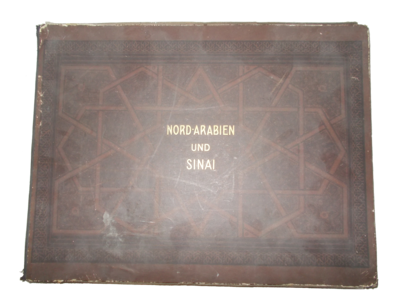
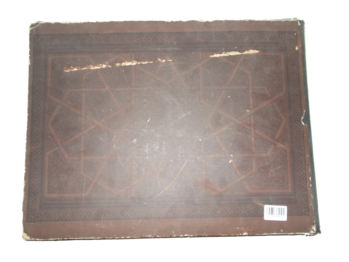
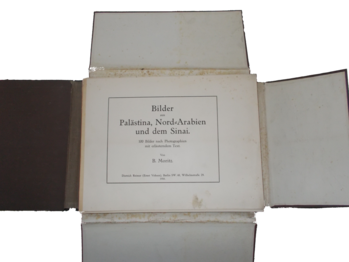
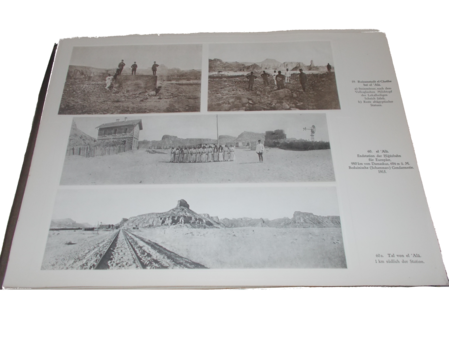
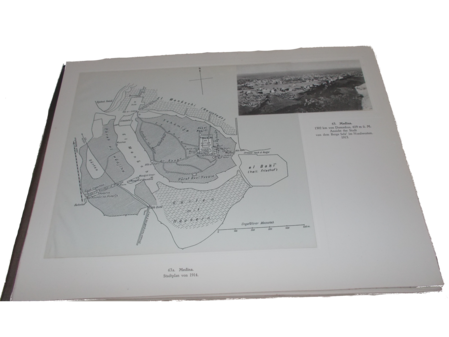
Rok wydania: 1916 / Publication year: 1916
Wydawnictwo: Dietrich Reimer Ernst Vohsen / Publisher: Dietrich Reimer Ernst Vohsen
Stan: Używana / Condition: Used
Rodzaj okładki: Twarda / Cover type: Hard
Język: Niemiecki / Language: German
Wymiar: 40x31cm / Dimension: 40x31cm
Ilość stron: 16 / Number of pages: 16
Waga: 3.5 kg / Weight: 3.5 kg
TIN: T00660445
100 Bilder nach Photographien mit erlauterndem Text.
Zbiór fotografii zebrany przez Bernharda Moritza z jego podróży na Bliski Wschód w latach 1905 - 1915. Z widokiem na Jerozolimę, Mekkę, Medynę, Hejaz i Jiddah w Arabii Saudyjskiej, Petrę w Jordanii i górę Synaj w Egipcie. Zbiór zawiera również widoki na wnętrza świątyń, meczety i pozostałości archeologiczne, sceny uliczne w Medynie, małych wioskach i widoki na pustynię. Zawiera także nieformalne portrety grupowe Arabów budujących Koleje Hejaz, koczowników, okolicznych mieszkańców i pielgrzymów na Hajj do Mekki.
A collection of photographs collected by Bernhard Moritz from his travels to the Middle East in the years 1905 - 1915. With a view of Jerusalem, Mecca, Medina, Hejaz and Jiddah in Saudi Arabia, Petra in Jordan and Mount Sinai in Egypt. The collection also includes views of the interior of the temples, mosques and archaeological remains, street scenes in Medina, small villages and views of the desert. It also includes informal group portraits of Arabs building Hejaz Railways, nomads, local residents and pilgrims to Hajj to Mecca.
Wstęp / Admission:
Die Veroffentlichung der vorliegend Bildersammlug wurde ermoglich durch die Gnade Sr. Majestat des Kaisers und Konigs. Allerhochstderselbe haben auf die Befurwortung des Koniglich Preussischen Kultus ministeriums einen Zuschuss zu den Herstellungskosten zu gewahren geruht, wofur ich auch an dieser Stelle meinen untertanigsten Dank darbringe. Die Sammlung enhalt eine Auswahl aus den Sammlungen von Photographien, die ich im Lauf wieder zusammengebracht habe.
Eine Anzahl davon, zumal die Bilder aus den, fur Europaer noch immer unzuganglichen Teilen des Higaz, verdanke ich turkischen Freunden, ebenso den Stadtplan von Medina, den ich trotz seiner Unvollkommenheit den Interessenten nicht vorenthalten mochte.
Uwagi: Oprawa lekko wytarta, rogi uszkodzone, druk czytelny, wewnętrzna część oprawy posiada niewielkie ślady pleśni oraz zabrudzenia, tylna oprawa mocno wytarta.
Notes: Binding little worn, corners damaged, legible print, inner part of the court frame with slight mold and dirt, back binding badly worn.
CENA / PRICE: 90 000 zł
W sprawie tej pozycji prosimy o kontakt z Biurem Obsługi Klienta pod numerem 18 549 20 10, email: sklep@tezeusz.pl
If You have any question please contact us: +48 18 549 20 10, email: sklep@tezeusz.pl
Der Kleine Herr Friedemann, 1920r. + Autograf - Thomas Mann
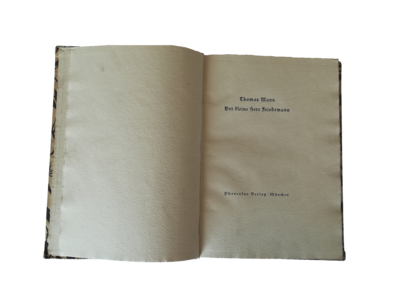
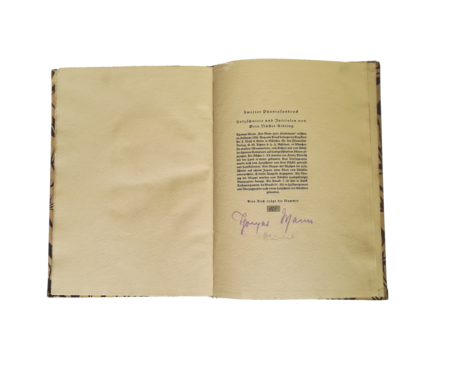
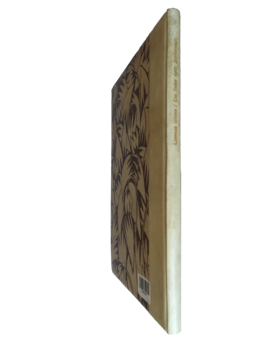
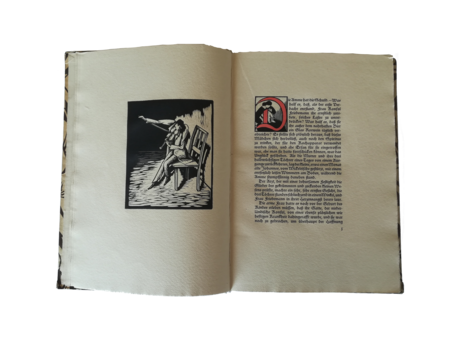
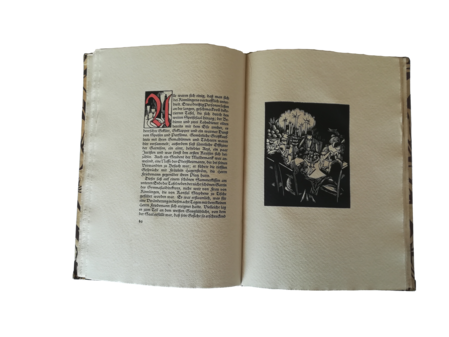
Rok wydania: 1920 / Publication year: 1920
Wydawnictwo: Phantasus Verlag Munchen / Publisher: Phantasus Verlag Munchen
Stan: Używana / Condition: Used
Rodzaj okładki: Twarda / Cover type: Hard
Język: Niemiecki / Language: German
Wymiar: 18x25cm / Dimension: 18x25cm
Ilość stron: 61 / Number of pages: 61
Waga: 0.3 kg / Weight: 0.3 kg
TIN: T00692087
UNIKAT. Tylko u nas! Książka z autografem Thomasa Manna!
Mały Pan Friedemann (tytuł oryginalny „Der Kleine Herr Friedemann”) to krótka powieść Thomasa Manna. Po raz pierwszy opublikowana została w 1897 r. jako wkład do magazynu „Neuen deutschen Rundschau”. Rok później (1898 r.) pojawiła się w zbiorze opowiadań Manna zwanych łącznie Der Kleine Herr Friedemann.
Historia zaczyna się gwałtownie, gdy pielęgniarka nadużywająca alkoholu upuszcza z przewijaka miesięcznego Johannesa Friedemanna, podczas gdy matka i trzy córki są nieobecne. Powoduje to poważne wady fizyczne. Friedemann dorasta zdeformowany i garbaty. Jako młody chłopak zakochuje się w dziewczynie, tylko po to, by znaleźć ją całującą się z drugą za żywopłotem. Wtedy też odrzuca miłość, poświęcając się samodoskonaleniu. Gdy w mieście pojawia się nowy komendant podpułkownik Rinnlingen wraz se swoją żoną Gerdą, Friedemann od razu się zakochuje. Jednak, Gerda odrzuca jego miłość co ma katastrofalne skutki.
Paul Thomas Mann – niemiecki prozaik i eseista, laureat literackiej Nagrody Nobla w 1929, uznawany za najwybitniejszego pisarza niemieckiego pierwszej połowy XX wieku i jednego z najwybitniejszych, obok Goethego, w dziejach literatury niemieckojęzycznej.
UNIQUE. Only here! Book autographed by Thomas Mann!
Little Mr. Friedemann (original title "Der Kleine Herr Friedemann") is a short novel by Thomas Mann. It was first published in 1897 as a contribution to the "Neuen deutschen Rundschau" magazine. A year later (1898) appeared in the collection of stories by Mann called together Der Kleine Herr Friedemann.
The story starts abruptly when the abusing nurse drops from the monthly Johannes Friedemann, while the mother and three daughters are absent. This causes serious physical defects. Friedemann grows up deformed and hunchbacked. As a young boy, he falls in love with a girl, only to find her kissing with the other behind the hedge. Then he also rejects love, devoting himself to self-improvement. When a new commander appears in the city, Lieutenant Colonel Rinnlingen and his wife Gerda, Friedemann falls in love immediately. However, Gerda rejects his love which has catastrophic consequences.
Paul Thomas Mann - German prose writer and essayist, laureate of the Nobel Prize in Literature in 1929, recognized as the greatest German writer of the first half of the twentieth century and one of the greatest, in addition to Goethe, in the history of German-language literature.
Uwagi: Oprawa zabrudzona, zakurzona, wytarta, naddarta, zagieta, pożółkła. Strony zabrudzone, zakurzone, wytarte, pożółkłe. Posiada adnotacje ołówkiem. Blok spójny. Druk czytelny.
Notes: The binding is dirty, dusty, worn, torn, bent, yellowed. Pages dirty, dusty, frayed, yellowed. Has annotated pencil. A consistent block. Print legible.
W sprawie tej pozycji prosimy o kontakt z Biurem Obsługi Klienta pod numerem 18 549 20 10, email: sklep@tezeusz.pl
If You have any question please contact us: +48 18 549 20 10, email: sklep@tezeusz.pl
Le paradoxe et le systeme -Yves Barel
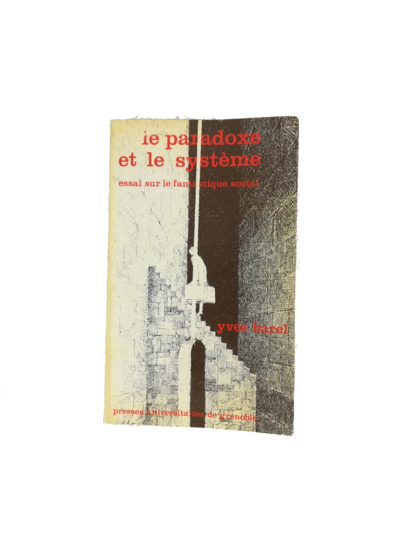
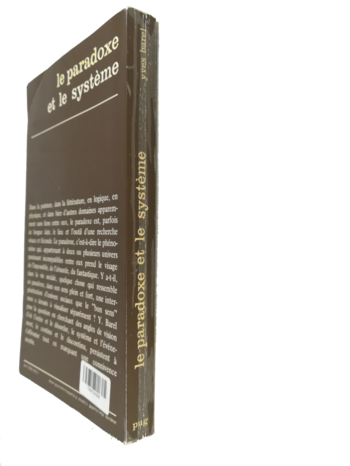
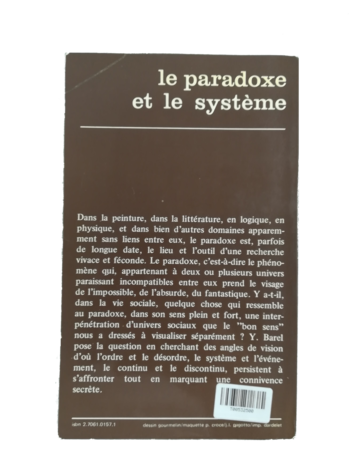
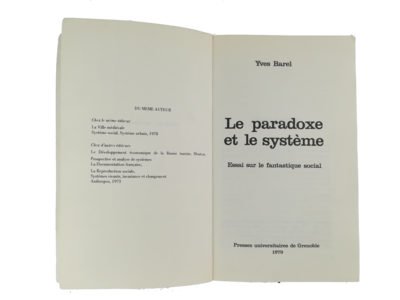
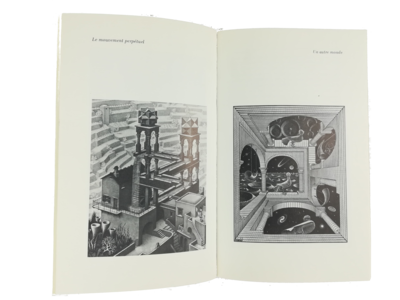
Rok wydania: 1979 / Publication year: 1979
Wydawnictwo: Presses Universitaires de Grenoble / Publisher: Presses Universitaires de Grenoble
Stan: Używana / Condition: Used
Rodzaj okładki: Miękka / Cover type: Soft
Język: Francuski / Language: French
Wymiar: 13.5x22cm / Dimension: 13,5x22 cm
Ilość stron: 275 / Number of pages: 275
Waga: 0.3 kg / Weight: 0.3 kg
TIN: T00532500
Książka wydana tylko w 2 tysiącach egzemplarzy!
Ten tekst to esej na temat relacji pomiędzy systemem społecznym, paradoksu i sprzeczności. W malarstwie, w literaturze, w logice, w fizyce i w wielu innych pozornie niezwiązanych ze sobą dziedzinach, paradoks jest, czasem przez długi czas, miejscem i narzędziem żywych i owocnych poszukiwań. Paradoks, to znaczy fenomen, który przynależny do dwóch lub więcej wszechświatów , które wydają się nie do pogodzenia ze sobą. Przyjmuje oblicze niemożliwego, absurdalnego, fantastycznego. Czy w życiu społecznym jest coś, co przypomina paradoks, w pełnym i silnym znaczeniu, przenikanie się wszechświatów społecznych, które zdrowy rozsądek sprawił, że wizualizujemy osobno? Yves Barel pyta szukając kąta dobrego widzenia, z którego porządek i nieporządek, system i zdarzenia, ciągłe i nieciągłe, nadal rywalizują.
Yves Barel - Ekonomista i epistemolog nauk społecznych. Dyrektor ds. Badań w Centre for Social Practice Studies, University of Grenoble (1987).
Book published only in 2 thousand copies!
This text is an essay on the relationship between the social system, paradox and contradictions. In painting, in literature, in logic, in physics and in many other seemingly unrelated fields, the paradox is, sometimes for a long time, a place and an instrument of living and fruitful searching. A paradox, that is, a phenomenon that belongs to two or more universes that seem incompatible with each other. It takes on the face of the impossible, absurd, fantastic. Is there anything in social life that resembles a paradox, in the full and strong sense, the penetration of the social universes, which common sense has made us visualize separately? Yves Barel asks for the angle of good vision from which order and disorder, system and events, continuous and discontinuous, continue to compete.
Yves Barel - Economist and epistemologist of social sciences. Research Director at the Center for Social Practice Studies, University of Grenoble (1987).
Uwagi: Oprawa lekko zabrudzona,szczególnie na krawędziach, rogi zagięte, kartki pożółkłe, oprawa delikatnie zagięta, brzegi stron trochę zabrudzone, folia na grzbiecie lekko naderwana.
Notes: Lightly soiled luminaire, especially on the edges, bent corners, yellowed pages, binding slightly bent, edges of pages slightly dirty, foil on the back slightly torn.
W sprawie tej pozycji prosimy o kontakt z Biurem Obsługi Klienta pod numerem 18 549 20 10, email: sklep@tezeusz.pl
If You have any question please contact us: +48 18 549 20 10, email: sklep@tezeusz.pl
Gazeta Warszawska, nr 89- 263, 1828 r. - Antoni Lesznowski
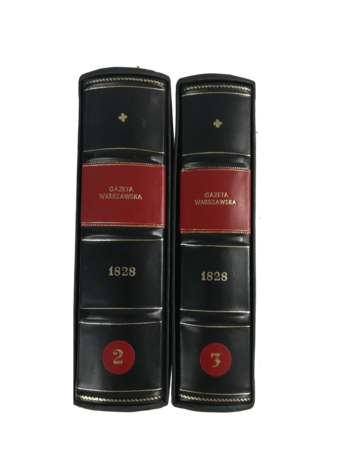
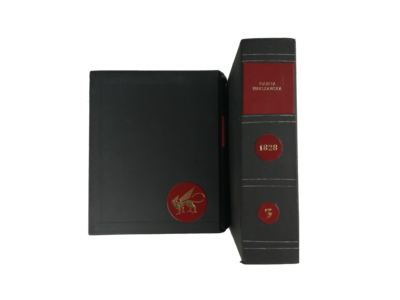
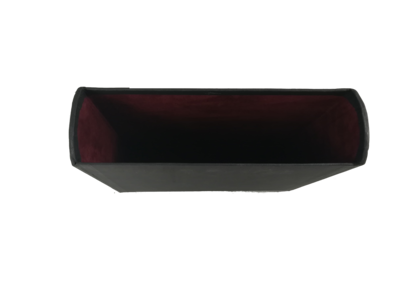
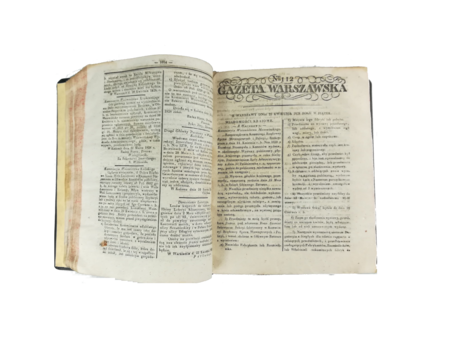
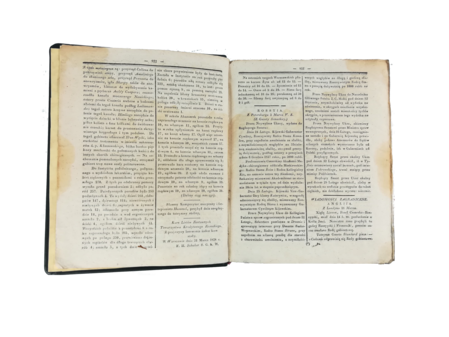
Rok wydania: 1828 / Publication year: 1828
Stan: Używana / Condition: Used
Rodzaj okładki: Twarda / Cover type: Hard
Język: Polski / Language: Polish
Wymiar: 20x23cm / Dimension: 20x23cm
Waga: 0,65 kg / Weight: 0,65 kg
TIN: T00671980
UNIKAT! Tylko u nas!
Gazeta Warszawska została założona po kasacie zakonu jezuitów w 1774 r., pierwotnie pod tytułem „Wiadomości Warszawskie”, była pierwszym ukazującym się regularnie dziennikiem.
Pierwszym redaktorem naczelnym i jednocześnie właścicielem gazety był jezuita Stefan Łuskina, który po kasacie zakonu, pozbawiony możliwości wykładania w kolegium jezuickim, zajął się dziennikarstwem. Zapewniwszy sobie na mocy przywileju królewskiego, wydanego 9 listopada 1773 r., monopol dziennikarski w Warszawie (gazeta nie docierała poza stolicę). Łuskina starał się nie dopuścić do powstania pism konkurencyjnych. Zresztą te starania nie musiały być tak mocne, bo po prostu w tamtym czasie nie było zapotrzebowania na inne tytuły.
Tom 2- Nr od 89 do 173, strony od 832 do 1854
Tom 3- Nr od 174 do 263, strony od 1855 do 2724
UNIQUE! Only here!
Gazeta Warszawska was founded after the dissolution of the Jesuit order in 1774, originally under the title "Wiadomości Warszawskie", it was the first daily published regularly.
The first editor-in-chief and at the same time the owner of the newspaper was the Jesuit Stefan Łuskina, who after the dissolution of the order, deprived of the opportunity to lecture in the Jesuit college, took up journalism. Having secured, on the strength of the royal privilege issued on November 9, 1773, a journalist monopoly in Warsaw (the newspaper did not reach beyond the capital). Łuskina tried to prevent the emergence of competitive writings. Besides, these efforts did not have to be so strong, because there was simply no demand for other titles at that time.
Volume 2- No. 89 to 173, pages 832 to 1854
Volume 3- No. 174 to 263, pages 1855 to 2724
Uwagi: Oprawy introligatorskie. Książki w etui. Etui wytarte, zakurzone, naddarte na krawędziach. Strony zabrudzone, zakurzone, wytarte, pożółkłe, poplamione, pozaginane. Blok spójny. Druk czytelny.
Notes: Bookbinding bindings. Books in a case. Case wiped, dusty, torn at the edges. Pages dirty, dusty, frayed, yellowed, stained, bent. A consistent block. Print legible.
W sprawie tej pozycji prosimy o kontakt z Biurem Obsługi Klienta pod numerem 18 549 20 10, email: sklep@tezeusz.pl
If You have any question please contact us: +48 18 549 20 10, email: sklep@tezeusz.pl
Bibliorum Sacrorum Graecus Codex Vaticanus, Tomus I-VI
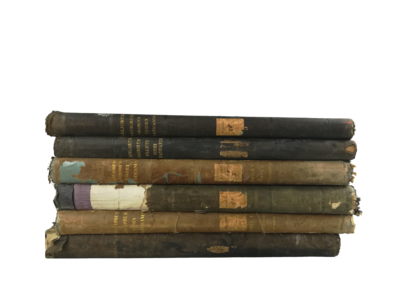
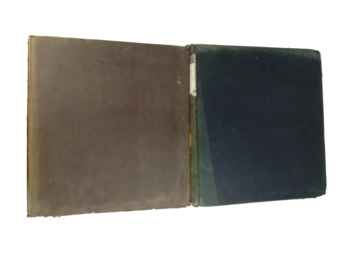
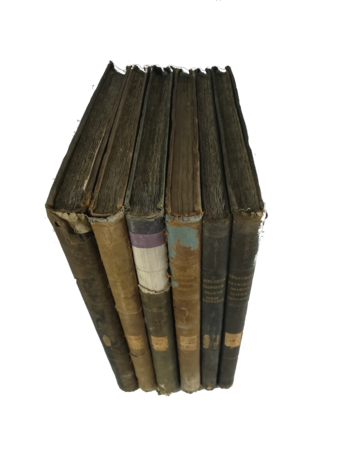
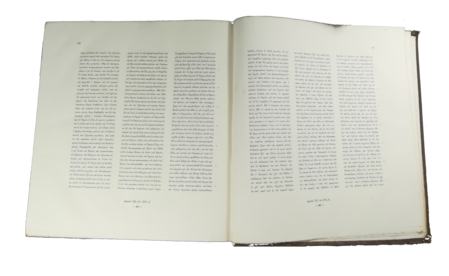
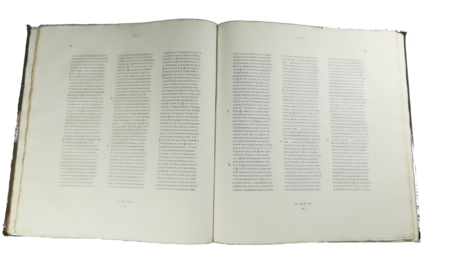
Rok wydania: 1870 / Publication year: 1870
Wydawnictwo: Typis et Impensis S. Congregationis de Propaganda Fide / Publisher: Typis et Impensis S. Congregationis de Propaganda Fide
Stan: Używana / Condition: Used
Rodzaj okładki: Twarda / Cover type: Hard
Język: Starogrecki / Language: Ancient Greek
Wymiar: 39x42,5 cm / Dimension: 39x42,5 cm
Waga: 10 kg / Weight: 10 kg
TIN: T00662319
UNIKAT. Dostępny tylko u nas!
Kodeks Watykański (łac. Codex Vaticanus, oznaczany symbolami B albo 03 według systemu Gregory-Aland, δ 1 według systemu von Sodena) – rękopis Starego i Nowego Testamentu, jeden z czterech wielkich kodeksów biblijnych. Pisany jest grecką uncjałą na pergaminie. Paleograficznie datowany jest na IV wiek. Nazwa kodeksu pochodzi od miejsca przechowywania, symbol B nadał jeszcze Wettstein, symbol 03 – Gregory. Również na liście rękopisów Septuaginty według Alfreda Rahlfsa otrzymał symbol B. Od ponad 500 lat przechowywany jest w Bibliotece Watykańskiej (Gr. 1209).
Kodeks stał się znany dzięki korespondencji Erazma z prefektami Biblioteki Watykańskiej, jednak jego tekst długo nie był dostępny. Wyciągi tekstu rękopisu wykonywano niedokładnie, z licznymi błędami i było to powodem wielu nieporozumień. Dopiero w końcu XIX wieku tekst rękopisu stał się w pełni dostępny dla badań.
Jest jednym z najstarszych i najlepszych rękopisów greckiej Biblii, do chwili odkrycia Kodeksu Synajskiego nie miał rywala na świecie. Krytycy tekstu wysoko oceniają tekst rękopisu i jest jednym z najczęściej wydawanych manuskryptów. Kodeks zachował się do dziś w bardzo dobrym stanie, ponieważ nie był zbyt często używany.
Tomus I - Pentateuchum et Librum Iosue- 1869 r., od 1 do 270 (270 s.)
Tomus II - Libros Iudicum, Ruth, Regnorum, Paralipomenon et Esdrae- 1870 r., od 271 do 624, (354 s.)
Tommus III - Libros Psalmorum, proverbiorum, Ecclesiastis, Cantici, Iob, Sapientiae Salomonis et Sirach- 1871r., od 625 do 893, (269s.)
Tomus IV - Libros Esther, Iudith, Tobiae et Prophetarum- 1872 r., od 893 do 1234, (312 s.)
Tomus V - Novum Testamentum- 1868 r., od 1235 do 1536, (302 s.)
Tomus VI - Prolegomena, Commentarios- 1881r., 168 s.
UNIQUE! Only here!
Vatican Codex (Latin Codex Vaticanus, designated with symbols B or 03 according to the Gregory-Aland system, δ 1 according to the von Soden system) - manuscript of the Old and New Testaments, one of the four great biblical codes. It is written in Greek on parchment. Palaeographically dated to the 4th century. The name of the codex comes from the place of storage, the symbol B also gave Wettstein, symbol 03 - Gregory. Also on the list of manuscripts, the Septuagint according to Alfred Rahlfs received the symbol B. For over 500 years, he has been kept in the Vatican Library (Gr. 1209).
The code became known thanks to Erasmus's correspondence with the prefects of the Vatican Library, but his text was not available for a long time. Extracts of the manuscript text were carried out inaccurately, with numerous errors and this was the reason for many misunderstandings. It was not until the end of the 19th century that the text of the manuscript became fully available for research.
It is one of the oldest and best manuscripts of the Greek Bible, until the discovery of the Sinai Code, it did not have a rival in the world. The text critics highly value the text of the manuscript and are one of the most widely published manuscripts. The Code has been preserved to a very good condition, because it was not used very often.
Tomus I - Pentateuchum et Librum Iosue- 1869 yr., from 1 to 270 (270 p.)
Tomus II - Libros Iudicum, Ruth, Regnorum, Paralipomenon et Esdrae- 1870 yr., from 271 to 624, (354 p.)
Tommus III - Libros Psalmorum, proverbiorum, Ecclesiastis, Cantici, Iob, Sapientiae Salomonis et Sirach- 1871 yr., from 625 to 893, (269 p.)
Tomus IV - Libros Esther, Iudith, Tobiae et Prophetarum- 1872 yr., from 893 to 1234, (312 p.)
Tomus V - Novum Testamentum- 1868 yr., from 1235 to 1536, (302 p.)
Tomus VI - Prolegomena, Commentarios- 1881 yr., 168 p.
Uwagi: Tom I - Oprawa zabrudzona, zakurzona, wytarta, pożółkła, postrzępiona, pozaginana, naddarta i uszkodzona na krawędziach. Grzbiet naderwany i pęknięty. Strony zabrudzone, zakurzone, wytarte, pożółkłe, pozaginane, postrzępione na brzegach. Blok spójny. Druk czytelny. Tom II - Oprawa zabrudzona, zakurzona, wytarta, pozaginana, uszkodzona na brzegach. Grzbiet uszkodzony, naderwany, pęknięty. Strony zabrudzone, zakurzone, wytarte, pożółkłe, postrzępione i nierówne na brzegach, kilka stron delikatnie odklejonych od bloku. Druk czytelny. Posiada podpisy i pieczątki. Tom III - Oprawa zabrudzona, zakurzona, wytarta, uszkodzona i naddarta na brzegach, postrzępiona na grzbiecie. Strony zabrudzone, zakurzone, wytarte, pożółkłe, postrzępione na brzegach. Posiada zapiski ołówkiem i pieczątki. Blok spójny. Druk czytelny. Tom IV - oprawa mocno wytarta, postrzępiona, pomarszczona, pozaginana, uszkodzona na krawędziach, naderwana na grzbiecie, pożółkła. Strony zabrudzone, kilka naderwanych, pożółkłe, poplamione, postrzępione i ponadrywane na brzegach. Druk czytelny. Tom V - Oprawa zabrudzona, zakurzona, wytarta, uszkodzona i naddarta na brzegach, postrzępiona na grzbiecie. Strony zabrudzone, zakurzone, wytarte, pożółkłe, postrzępione na brzegach. Posiada zapiski ołówkiem i pieczątki. Blok spójny. Druk czytelny. Tom VI - Oprawa zabrudzona, zakurzona, wytarta, pożółkła, poplamiona, naddarta na brzegach. Uszkodzona na grzbiecie. Strony zabrudzone, zakurzone, wytarte, pożółkłe, pomarszczone, poplamione. Druk czytelny. Blok spójny.
Notes: Volume I - Binding dirty, dusty, worn, yellowed, frayed, bent, torn and damaged on the edges. The ridge torn and cracked. Pages dirty, dusty, frayed, yellowed, bent, jagged around the edges. A consistent block. Print legible. Volume II - Binding dirty, dusty, worn, bent, damaged on the edges. Back ruptured, torn, cracked. Pages dirty, dusty, frayed, yellowed, jagged and uneven on the edges, a few pages gently peeled off the block. Print legible. Has signatures and stamps. Volume III - Binding dirty, dusty, worn, damaged and torn at the edges, frayed on the back. Pages dirty, dusty, frayed, yellowed, frayed around the edges. It has pencil notes and stamps. A consistent block. Print legible. Volume IV - binding heavily worn, frayed, wrinkled, bent, damaged on the edges, torn on the back, yellowed. Pages dirty, a few torn, yellowed, stained, frayed and covered over the edges. Print legible. Volume V - Binding dirty, dusty, worn, damaged and torn at the edges, frayed on the back. Pages dirty, dusty, frayed, yellowed, frayed around the edges. It has pencil notes and stamps. A consistent block. Print legible. Volume VI - Binding dirty, dusty, worn, yellowed, stained, torn on the edges. Damaged on the back. Pages dirty, dusty, frayed, yellowed, wrinkled, stained. Print legible. A consistent block.
W sprawie tej pozycji prosimy o kontakt z Biurem Obsługi Klienta pod numerem 18 549 20 10, email: sklep@tezeusz.pl
If You have any question please contact us: +48 18 549 20 10, email: sklep@tezeusz.pl
Reise - Erinnerungen ok. 1884 r.
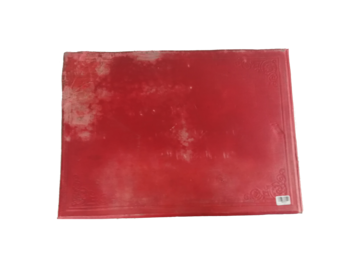
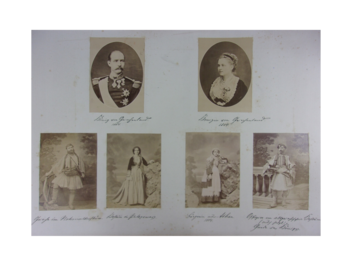
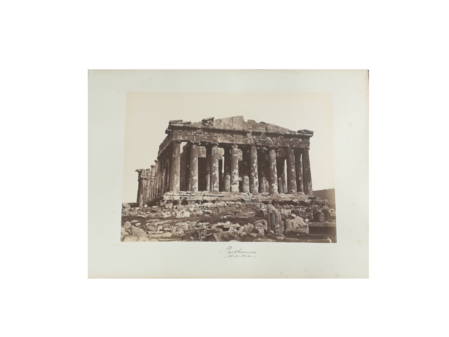
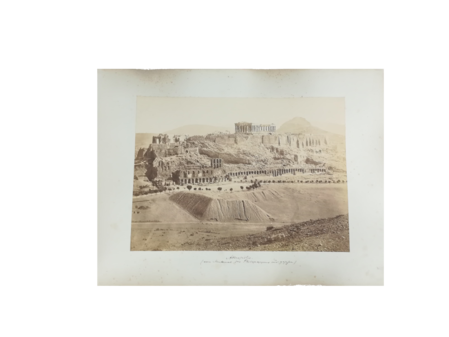
Rok wydania: 1884 / Publication year: 1884
Stan: Używana / Condition: Used
Rodzaj okładki: Twarda / Cover type: Hard
Wymiar: 55x39 cm / Dimension: 55x39 cm
Waga: 5 kg / Weight: 5 kg
TIN: T00683818
UNIKAT. Tylko u nas!
Album zawierający fotografie zabytków aglomeracji Wielkie Ateny obejmującej Ateny i Pireus oraz ich miasta satelickie. Zdjęcia przedstawiają między innymi: Partenon, miasto Akropolis, port Pireus, Świątynie Zeusa Olimpijskiego – Olimpiejon.
Akropol ateński (nw.gr. Ακρόπολη Αθηνών, od akropolis = górne miasto) to położone w Atenach wapienne wzgórze. Był ufortyfikowanym wzgórzem, na którym już w czasach mykeńskich zbudowano cytadelę. W okresie późniejszym Akropol stał się miejscem kultu. Świątynie zbudowane w okresie archaicznym zostały zniszczone podczas wojen perskich. Podczas odbudowy zainicjowanej przez Peryklesa powstał tu kompleks świątyń, m.in.: Partenon, Erechtejon, Apteros oraz sanktuarium Artemidy.
UNIQUE. Only here!
Album containing photographs of the monuments of the Greater Athens agglomeration including Athens and Piraeus and their satellite cities. The pictures show, among others: the Parthenon, the city of Akropolis, the port of Piraeus, the Temples of Olympian Zeus.
The Acropolis of Athens (n.gr. Ακρόπολη Αθηνών, from akropolis = upper city) is a limestone hill in Athens. It was a fortified hill, where a citadel was built in Mycenaean times. Later, Acropolis became a place of worship. Temples built in the archaic period were destroyed during the Persian wars. During the reconstruction initiated by Pericles, a complex of temples was established here, including the Parthenon, the Erechtheum, the Apteros and the sanctuary of Artemis.
Uwagi: Oprawa zabrudzona, zakurzona, wytarta, zagięta, naddarta na brzegach, poplamiona, wypłowiała z tyłu na rogu, uszkodzona na rogach. Brzegi stron zabrudzone, zakurzone. Strony zabrudzone, zakurzone, wytarte, pożółkłe, poplamione, pozaginane, pierwsza strona delikatnie naderwana. Zdjęcia w bardzo dobrym stanie. Wszystko widoczne. Blok spójny.
Notes: The binding is dirty, dusty, worn, bent, torn around the edges, stained, faded from the back on the corner, damaged on the corners. The edges of the pages are dirty, dusty. Pages dirty, dusty, frayed, yellowed, stained, bent, first page slightly torn. Pictures in very good condition. Everything visible. A consistent block.
W sprawie tej pozycji prosimy o kontakt z Biurem Obsługi Klienta pod numerem 18 549 20 10, email: sklep@tezeusz.pl
If You have any question please contact us: +48 18 549 20 10, email: sklep@tezeusz.pl
Polska jej dzieje i kultura, , Tom I-III, 1927 r. - Bronisław Gembarzewski (opr.)
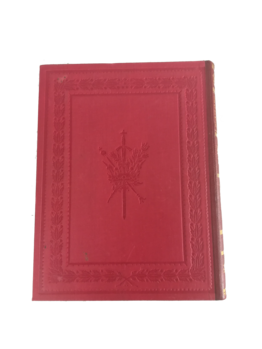
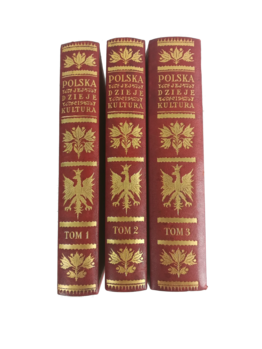
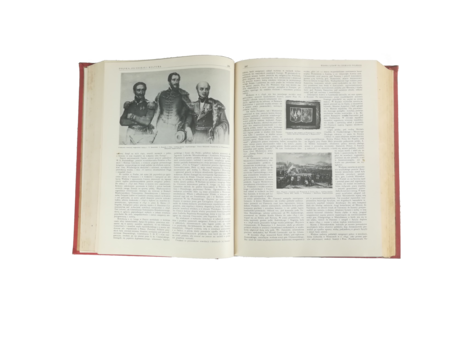
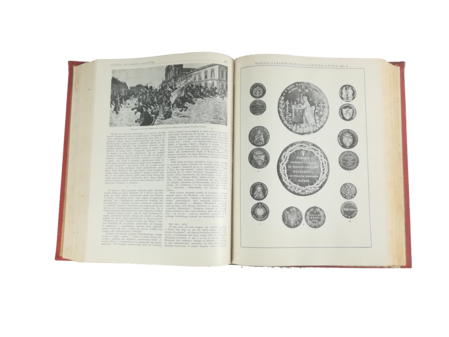
Rok wydania: 1927 / Publication year: 1927
Wydawnictwo: Nakładem Księgarni Trzaski, Everta i Michalskiego / Publisher: Nakładem Księgarni Trzaski, Everta i Michalskiego
Stan: Używana / Condition: Used
Rodzaj okładki: Twarda / Cover type: Hard
Język: Polski / Language: Polish
Wymiar: 25x32 cm / Dimension: 25x32 cm
Waga: 6 kg / Weight: 6 kg
TIN: T00700553
UNIKAT. Tylko u nas!
Pomnikowe dzieło wydane z inicjatywy St. Lama, J. Michalskiego i Wł. Trzaski.
Autorzy tekstów: A. Antoniewicz, St. Arnold, Al. Bruckner, St. Dobrzycki, Br. Gembarzewski, R. Grodecki, M.Gumowski, O. Halecki, Z. Jachimecki, F. Kopera, J.St. Bystroń, A. Skałkowski, W. Sobieski, T. Grabowski, M. Kukiel, A. Lewak, T. Pini, A. Szelągowski, W. Tokarz.
Twarda oprawa wydawnicza z epoki półskórek zaprojektowana przez F. J. Radziszewskiego, a wykonana przez introligatornię artystyczną w Warszawie. Na wszystkich okładkach stylizowany orzeł w otoczeniu 16 herbów miast wojewódzkich, efektowne grzbiety powielające element orła i charakterystyczne zdobnictwo Radzika. W każdym tomie bardzo liczne ilustracje w tekście, mapy, wykresy, tablice jedno i wielobarwne.
Tom 1: Od pradziejów do roku 1572 - 590 s.
Tom 2: Od roku 1872-1795 - 598 s.
Tom 3: Od roku 1796-1930 - 976 s.
UNIQUE. Only here!
A monumental work issued on the initiative of St. Lama, J. Michalski and Wł. Trzaska.
Authors of the texts: A. Antoniewicz, St. Arnold, Al. Bruckner, St. Dobrzycki, Br. Gembarzewski, R. Grodecki, M. Gumowski, O. Halecki, Z. Jachimecki, F. Kopera, J.St. Bystroń, A. Skałkowski, W. Sobieski, T. Grabowski, M. Kukiel, A. Lewak, T. Pini, A. Szelągowski, and W. Tokarz.
A hard, half-cycle publishing design designed by F.J. Radziszewski, and made by an artistic bindery in Warsaw. On all covers, a stylized eagle surrounded by 16 coats of provincial cities, spectacular ridges duplicating the element of the eagle and the characteristic ornamentation of Radzik. In each volume, very numerous illustrations in the text, maps, graphs, single and multi-colored boards.
Volume 1: From prehistory to 1572 - 590 pages
Volume 2: From 1872-1795 - 598 pages
Volume 3: From 1796-1930 - 976 pages
Uwagi: Oprawy wytarte, uszkodzone na rogach, kartki pożółkłe, lekko poplamione , brzegi stron zabrudzone, bloki spójne, druki czytelne
Notes: Luminaires worn, damaged on the corners, yellowed pages, slightly stained, edges of the pages dirty, consistent blocks, legible prints
W sprawie tej pozycji prosimy o kontakt z Biurem Obsługi Klienta pod numerem 18 549 20 10, email: sklep@tezeusz.pl
If You have any question please contact us: +48 18 549 20 10, email: sklep@tezeusz.pl
Architektonische Bilderbogen, 1888 r. - Wilhelm Wicke
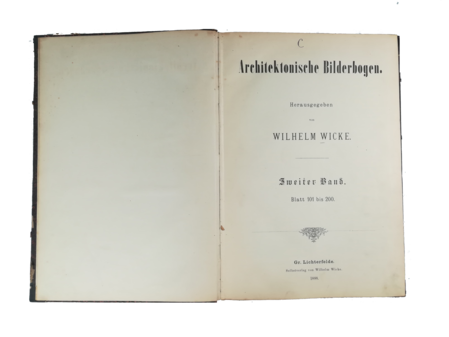
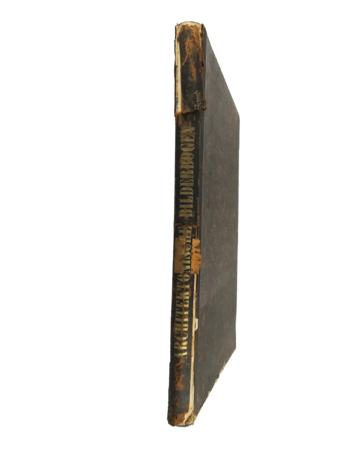
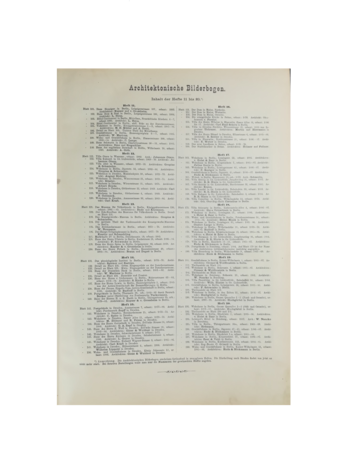
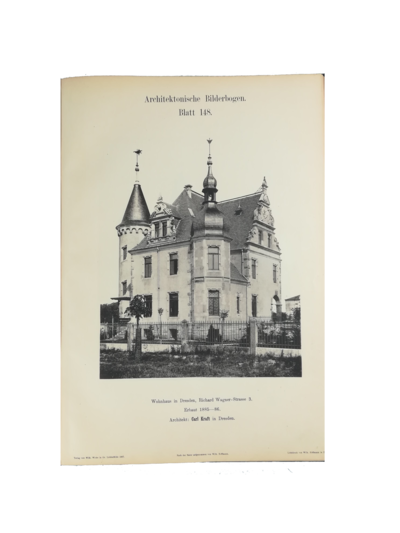
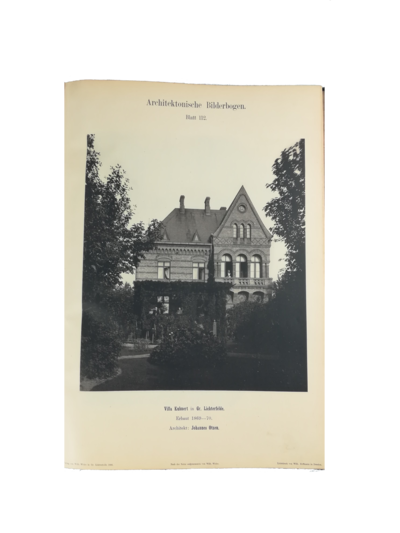
Rok wydania: 1888 / Publication year: 1888
Wydawnictwo: Gr. Lichterfelde / Publisher: Gr. Lichterfelde
Stan: Używana / Condition: Used
Rodzaj okładki: Twarda / Cover type: Hard
Język: Niemiecki / Language: German
Wymiar: 27x40 cm / Dimension: 27x40 cm
Ilość stron: 200 / Number of pages: 200
Waga: 2 kg / Weight: 2 kg
TIN: T00673887
Zbiór obrazów architektonicznych z ponumerowanymi pojedynczymi arkuszami łącznie obejmuje 89 czarno-białych zdjęć budynków w Niemczech w latach 1884-1886. W zbiorze możemy znaleźć między innymi fotografie Starego Muzeum (Altes Museum), Stacji Lehrter (Lehrter Bahnhof) oraz najstarszego teatru operowego zbudowanego w Berlinie (Königl Schauspielhaus). W celu uzyskania pełnej listy zabytków zawartych w zbiorze prosimy o kontakt.
The collection of architectural images with numbered single sheets together includes 89 black and white photographs of buildings in Germany in the years 1884-1886. The collection includes photographs of the Old Museum (Altes Museum), Lehrter Station (Lehrter Bahnhof) and the oldest opera house built in Berlin - Königl Schauspielhaus. In order to obtain a full list of monuments contained in the collection, please contact us.
Uwagi: Oprawa mocno wytarta, zabrudzona, mocno uszkodzona na rogach i grzbiecie, kartki pożółkłe, poplamione, blok spójny, druk czytelny
Notes: The binding is heavily worn, dirty, heavily damaged on the corners and the back, yellowed, stained, cohesive block, legible print
W sprawie tej pozycji prosimy o kontakt z Biurem Obsługi Klienta pod numerem 18 549 20 10, email: sklep@tezeusz.pl
If You have any question please contact us: +48 18 549 20 10, email: sklep@tezeusz.pl

